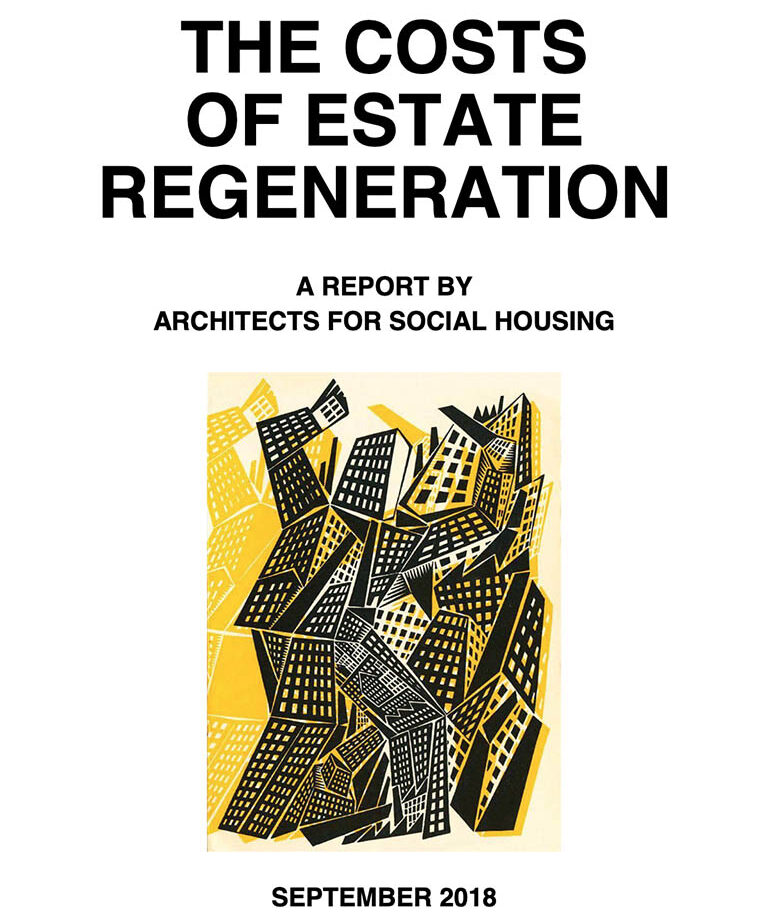The Costs of Estate Regeneration
A report by Architects for Social Housing
One of the biggest problems faced by residents informed that their estate is being considered for ‘regeneration’ is the disinformation they are given by the local authority or housing association implementing the process. This is compounded by the council officers who run the unelected Resident Engagement Panels and Steering Groups formed to persuade resident representatives of the benefits of regeneration; by the professional consultants employed to manufacture resident consensus for what they have been told will happen; by the architects who visualise the promises of what regeneration will means for residents; and ultimately by the property developers who will build the new development. For whatever residents are initially told about ‘regeneration’, on estates built on London’s lucrative land, this invariably means the demolition of the existing estate, the redevelopment of new properties at greatly increased densities, and the privatisation of the management and maintenance of the new development.
This problem of disinformation, however, isn’t confined to residents. Housing campaigners trying to resist the demolition of residents’ homes, as well as the journalists who occasionally write about their campaigns, share the same misunderstandings about the costs of estate ‘regeneration’. As a result, such campaigns of resistance are almost entirely confined to ethical arguments about the right of the estate community to continue to exist. These arguments are important, but they are of no concern to the agents of regeneration: either to the developers after the land residents’ homes are built on, or to the council undertaking the process of moving them off it. The registered social landlord, whether local authority or housing association, will make gestures of appeasement towards those rights right up to the moment residents are forcibly evicted from their homes; but those arguments will have little or no influence on what gets built on the land cleared of the demolished homes. What determines that is one thing, and one thing only: the financial costs of demolishing and redeveloping estates.
It is important, therefore, that residents and campaigners understand these costs, and can base their resistance to the estate regeneration programme that is clearing the land for London’s property boom not only on arguments about ethics, but on a clear understanding of what will result from the continued demolition of the city’s housing estates in the middle of a crisis of housing affordability. The financial figures show that, if an estate regeneration scheme begins by demolishing the existing estate – which is current policy for London’s Conservative, Labour and Liberal Democrat councils, the Greater London Authority and the UK Government – the cost of demolition, compensation for leaseholders and tenants and the construction of new-build dwellings is so high in today’s housing market that the resulting redevelopment will overwhelmingly be made up of properties for private sale, with a hugely reduced number of homes for social rent, increased rental and service charges for existing council tenants, and enormously increased sale prices and reduced tenancy rights for leaseholders.
It is on the basis of this understanding that over the past six years Architects for Social Housing has developed its design alternatives to estate demolition for five London estates, including the Knight’s Walk and Central Hill estates in Lambeth, the West Kensington and Gibbs Green estates in Hammersmith and Fulham, and the Northwold estate in Hackney. These design proposals increased the housing capacity on the estate by between 35 and 50 per cent without demolishing a single existing home. In addition, the funds raised from the market sale and rent of around half of the new builds meant the other half were able to be allocated as homes for social rent. Finally, the sale and rent revenues from the new builds generated the funds to refurbish and improve the current estate up to the Decent Homes Standard and higher. The ASH model of estate regeneration through refurbishment and infill new development is easily the most socially beneficial and environmentally sustainable option to address the crisis of housing affordability in London; but it is also the only financial option that doesn’t result in the social cleansing of existing residents from their estate and the mass loss of homes for social rent that is being implemented by the estate regeneration programme in its current form.
See here for ASH’s report on the Costs of Estate regeneration

